The Hard Case: Factoring Quadratics with a Box
Purplemath
What is a "hard" quadratic?
A "hard" quadratic is one whose leading coefficient (that is, whose numerical value on the x2 term) is something other than a nice, well-behaved 1. To factor a "hard" quadratic, we have to handle all three coefficients, not just the two we handled in the "easy" case, because the leading coefficient adds to the mix and makes things much messier.
Content Continues Below
How do you factor a quadratic when a is not 1?
To factor a quadratic (that is, to factor a trinomial of the form ax2 + bx + c) where the leading coefficient a is not equal to 1, follow these steps:
- Multiply the leading coefficient a and the constant term c to get the product ac.
- Find factors of ac that add up to the coefficient of the constant term b.
- Use these factors of ac to split the middle term bx into two terms.
- Factor the resulting four-term polynomial "in pairs", or else (which is the simpler way) apply "Box".
What is "Box"? We'll get to that shortly.
The first step in factoring these hard quadratics will be to multiply "a" and "c". Then we'll need to find factors of the product "ac" that add up to "b". So the "adding up to" part is the same as for the case of factoring where the leading coefficient was 1 (that is, we're still finding factors that add up to the middle term's coefficient), but finding those factors will be harder because we've got more information going into that stage of the process.
However, hard factoring is still quite do-able. We'll be using a method called "The Box Method", which is based on the a-b-c method, which has been around since at least the mid-1980s. The Box Method is newer, but I've found it to be easier; yes, I use it myself.
What is an example of factoring a quadratic using the Box Method?
- Factor 2x2 + x − 6
There is no factor common to all three terms (that is, there is no gcf), so I can't pull anything out of all three terms. The leading coefficient is not 1, so I'll need to use a more-powerful factoring method than what I used on the previous page.
Advertisement
Looking at the coefficients of this quadratic expression, I have a = 2, b = 1, and c = −6, so ac = (2)(−6) = −12.
This tells me that I need to find factors of −12 that add up to +1. The factor pairs for 12 (not considering signs) are 1 and 12, 2 and 6, and 3 and 4.
Affiliate
Since what I'm multiplying to (namely, −12) is "minus", I know that need one factor to be "plus" and the other to be "minus" (because "plus" times "minus" is "minus").
I need my factors to add to 1; since the factors will have opposite signs, this tells me that I'll need the factors to be one unit apart (other than for their signs). This means that I'll want to use the pair 3 and 4.
Also, since I'll be adding these factors to get a "plus", I know that I'll need to put the "plus" on the larger of the two factors. In other words, I'll want the 4 to be "plus" and the 3 to be "minus", because:
(−3)(4) = −12 = ac
−3 + 4 = +1 = b
Now that I have found my factors, I will use a four-square box, or grid, to keep track of everything for me.
To start, I will draw a two-by-two grid, putting the first term of the original quadratic expression in the upper left-hand square and the last term of the quadratic in the lower right-hand square, like this:
|
|
|
|---|---|---|
|
2x2 |
|
|
|
−6 |
(I'll be writing stuff down along the left-hand side and across the top of this Box, which is why I've left some extra space along those edges.)
I'm using −3 and +4 to split the quadratic's middle term; that is, I'm using them to split up the +x term. So I will take my factors −3 and 4 and put them, complete with their signs and the variable, in the diagonal corners, like this:
|
|
|
|---|---|---|
|
2x2 |
−3x |
|
+4x |
−6 |
(It doesn't matter which way you do the diagonal entries; the answer will work out the same, either way.)
Now that I've got everything set up, I can let the Box keep track of things for me; in particular, I can let Box keep track of the signs for me. I will factor whatever I can from each row, putting whatever I can pull out on the left-hand side of the Box, next to that row; and I'll factor whatever I can from each column, putting whatever I can pull out along the top of the Box, above that column. The steps look like this:
from the top row:
|
|
|
|---|---|---|
x |
2x2 |
−3x |
|
+4x |
−6 |
from the bottom row:
|
|
|
|---|---|---|
x |
2x2 |
−3x |
+2x |
+4x |
−6 |
from the left column:
|
2x |
|
|---|---|---|
x |
2x2 |
−3x |
+2 |
+4x |
−6 |
from the right column:
|
2x |
−3 |
|---|---|---|
x |
2x2 |
−3x |
+2 |
+4x |
−6 |
How did I decide the which of −3x and the +4x went in which square inside the Box? I didn't, really; I just picked whatever I felt like. The answer will come out the same, regardless of the order in which you insert these "splitting the middle term" values. (If you're not sure, try it and see.)
How did I figure out the signs for the values that I'd factored out from the bottom row and the right-hand column? I didn't, really; I just took whatever was the sign on the closest term from which I'd factored. For the top row and the left-hand column, I'll always have the leading ax2 term first (in the top row and left-hand column), so I don't bother with the "plus" sign for these factorings. But for the bottom row and the right-hand column, I must religiously copy the closest sign when I do the factorization.
Now that I have factored the Box, I can read off my answer from across the top and along the left-hand side, including those signs from the right-hand column and the bottom row. Across the top, I get the factor 2x − 3; along the side, I get the factor x + 2. So my answer is:
(2x − 3)(x + 2)
Content Continues Below
If your text or your teacher factors "by grouping" (that is, in pairs), you'll find that it is very easy to make mistakes with the signs. Using that method, you'll still have to find the factors of ac that add up to b (being, in this example, the factors "−3 and +4"), but your steps would look like this:
2x2 + x − 6
ac = (2)(−6) = −12
b = +1: use +4, −3
2x2 + 4x − 3x − 6
2x(x + 2) − 3(x + 2)
(x + 2)(2x − 3)
You would get the same answer by using grouping to do the factorization, but my students (and me, too) have always found Box to be easier and more reliable, especially in cases like the one above where you're having to try to keep track of "minus" signs.
Why is the Box Method of factoring better?
In my experience, students using "by grouping" to do their factorizations get in the habit of dropping the sign in the middle ("isn't it always a 'plus' sign?") and generally forget to factor the "minus" sign out of the second "group" correctly. Without the Box Method, it's just too easy to get lost in the middle of your work.
For the quadratic above, students trying to factor with just the grouping method would all too often drop "minus" signs and do something like this:
Don't do this!
2x2 + 4x − 3x − 6
2x(x + 2) 3(x − 2)
...ummmm....
Or else, as soon as they get their first parenthetical, they'll assume that the other one will work out the same way, and they'll do something like this:
Don't do this, either!
2x2 + 4x − 3x − 6
2x(x + 2)3(x + 2)
(x + 2)(2x + 3)
It was this continual confusion with the signs in the middle that led me to switch from factoring "by grouping" to using Box. My students do better with Box, and I do better with Box. As always, of course, you should use whatever works best for you, but please do give Box a fair hearing.
"Box" does take a little getting used to, but it's worth the effort, so let's do some more exercises:
- Factor 4x2 − 19x + 12
There are no common factors, so there is nothing that I can pull out of all three terms. The leading coefficient is not 1, so I'll need to use Box to factor.
The coefficients are a = 4, b = −19, and c = 12, so I'll be looking for numbers that multiply to get ac = 48.
Since the 48 is "plus", I will need two factors that are either both "plus" or else both "minus" (because "plus" times "plus" is "plus", and "minus" times "minus" is "plus"). Since −19 is "minus", I will need my factors both to be "minus". This means that I will need a pair of numbers that sum to 19.
The pairs of factors for 48, and their sums, are:
1, 48: 1 + 48 = 49
2, 24: 2 + 24 = 26
3, 16: 3 + 16 = 19
4, 12: 4 + 12 = 16
6, 8: 6 + 8 = 14
Since −3 + (−16) = −19, I will use −3 and −16 to split the −19 coefficient on the middle term. The animation below shows, with arrows, what my steps are, in sequence, while filling in Box and then doing my factorization:

synopsis of animation:

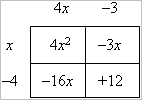
To see the full animation, please visit the "live" page online.
Then my factorization is:
(x − 4)(4x − 3)
Take especial note of the factor-pairs listing I did in the two examples above. Sometimes, it will be immediately (or at least pretty quickly) clear what factors you should use. However, when in doubt, and especially for really large products, listing out all the pairs (or at least all the pairs until you hit the one you want) can be a vital time-saver.
Affiliate
What is an example of where the Box Method doesn't work?
-
Factor 5x2 − 10x + 6
There is no common factor, so there's nothing that I can pull out of all three terms. The leading coefficient is 5, not 1, so I'll need to apply Box.
Affiliate
Looking at the three coefficients, I have a = 5, b = −10, and c = 6, so I'll be multiplying to ac = +30.
Since ac is "plus", then both factors will have the same sign. Since b is "minus", then the sign on both will be "minus". Because the factors have the same sign, I'll need to find factors which add up to 10 (and then slap "minus" signs on them).
The pairs of factors of 30, and their sums, are:
1, 30: 1 + 30 = 31
2, 15: 2 + 15 = 17
3, 10: 3 + 10 = 13
5, 6: 5 + 6 = 11
Um... none of these pairs sums to 10. What do I do know?
I remember that, when something doesn't factor, it's prime. Since there is no pair of factors that sum to ten, then there is no way to factor this, so this is a prime polynomial. If I want to get really fancy, I can state my answer as:
unfactorable over the integers
What does the above answer mean? The factorization process requires us to find a pair of integers (that is, whole numbers, and their negatives) that lets us split that middle term helpfully. If we can't find integers that work, then we can't do the factorization. In other words, we weren't able to factor by using integers. And, by listing all of the factor pairs, I am sure that I can't factor this quadratic, because I was able to confirm by checking the complete list. If there's no match in the list, then there is no factorization using the integers that they're wanting us to use at this stage of your studies.
While "unfactorable over the integers" is technically and completely accurate terminology, it's more common to refer to quadratics that don't factor using a pair of integers as being "prime" or simply "unfactorable". The specific terminology you should use will probably depend upon your text. If you're not sure, ask your teacher before the next test.
URL: https://www.purplemath.com/modules/factquad2.htm
Select a Course Below
Standardized Test Prep
Homeschool Math
© 2024 Purplemath, Inc. All right reserved. Web Design by ![]()



